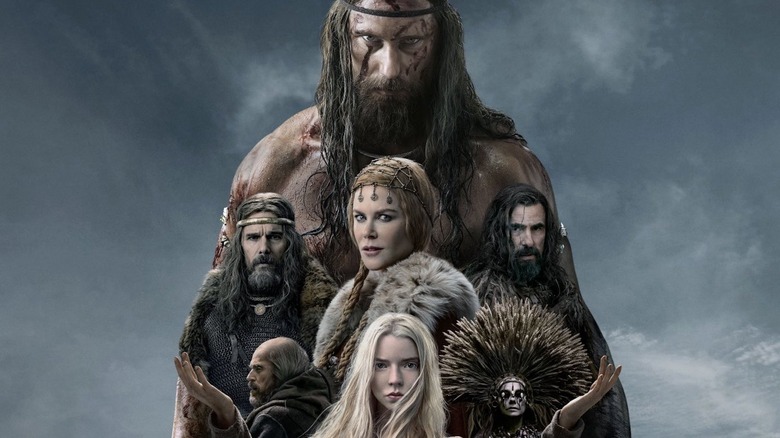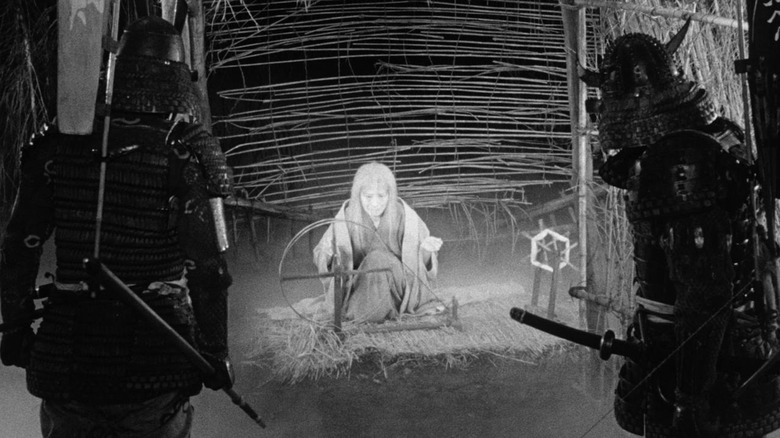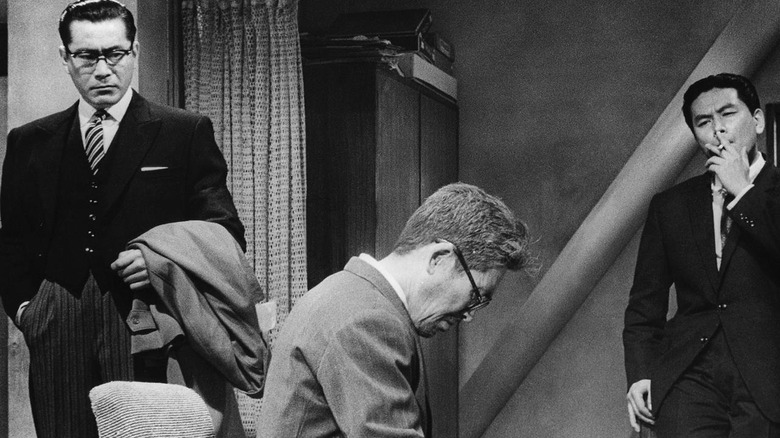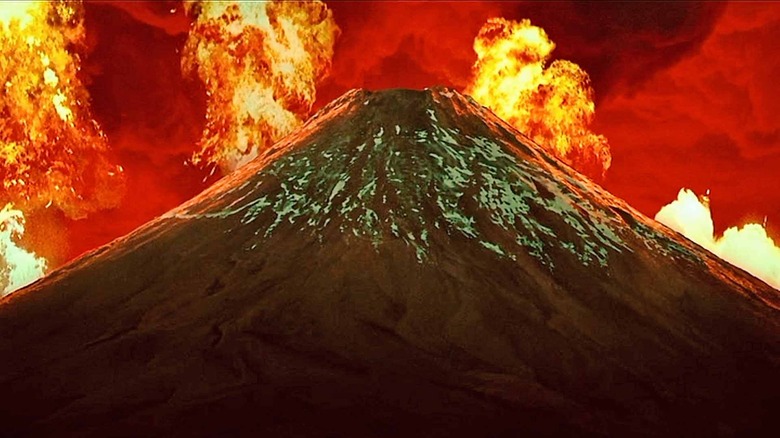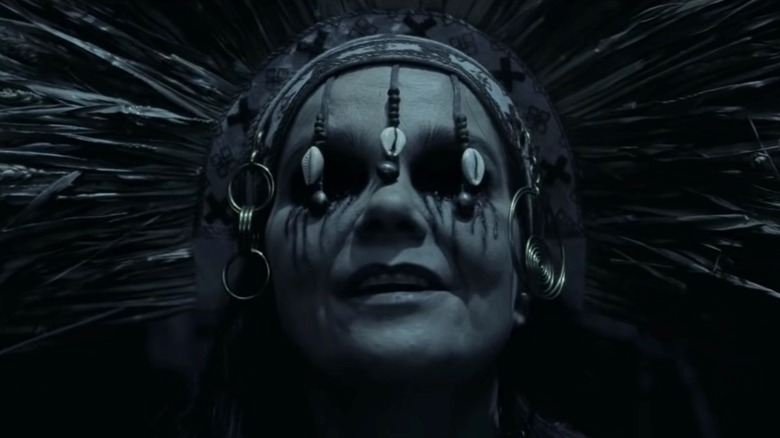The Northman Is A Dream For Akira Kurosawa Fans
Robert Egger's "The Northman" is based on the Norse myth of Amleth, which was a chief inspiration for Shakespeare as he crafted "Hamlet." The story of a man killing his brother king and marrying the dead man's wife, leaving the dead man's son to find his own place in the story and exact revenge feels as old as time itself. It's impossible to look at the original myth and not think about the reformulations of the Bard, and Eggers seems to have approached the text like a mix between "Hamlet" and "Macbeth."
The film itself is Eggers at his most mainstream and action oriented, but still leaves enough of his signature darkness, symbolism, and flat out weirdness to make it one of the best movies to come out in 2022.
Throne of Blood and Macbeth
Another filmmaker who tread this Shakespearean territory with aplomb was Akira Kurosawa, albeit with samurai rather than Vikings. Kurosawa's 1957 classic "Throne of Blood" is a Japanese retelling of "Macbeth," replete with creepy forest witches and a sealed fate and pre-written destiny for all involved. Whether Eggers was consciously borrowing from Kurosawa or not we don't know, but there are striking similarities that feel undeniable to fans of both films.
In "The Northman," Björk plays a seeress that feels very much like the witches in Kurosawa's "Throne of Blood." In both films, these witches lay out the destiny for the main characters. In "The Northman," that's Alexander Skarsgård as Amleth, and in "Throne of Blood," it's Toshiro Mifune as Washizu. Neither of them know how their fates will play out, only that they will. Both are under immense pressure to see how these foretold destinies will mean for them. In the end, these fortunes told are fatal for our protagonists, as they wind through stories where they discover more and more that they can't trust who they thought they could and things aren't always as they seem.
Kurosawa's "Throne of Blood" has an otherworldly quality to it that Eggers offers a modern sort of take on. There's a famous shot in the samurai picture where the camera and characters step into a witches hut, but when it pulls back out, the entire hut has vanished. It was cutting edge for 1957, Eggers pulls many similar tricks, but with the flourishes of 2022's cinema technology.
Hamlet and The Bad Sleep Well
Kurosawa took on "Hamlet" in a more direct fashion himself with his 1960 noirish look at corporate corruption called "The Bad Sleep Well." This film starred Toshiro Mifune again, as Nishi, a Japanese stand-in for Hamlet. In that film, Nishi's father is killed by a corporate boss and he works to expose the murder and force those who killed his father to pay. In Shakespeare's "Hamlet," a play is staged for the benefit of the murdering uncle, so that Hamlet can gauge his reaction in public and begin to sow doubt and guilt in the minds of his enemy. In "The Bad Sleep Well," Kurosawa replaces the play with a wedding cake, a massive replica of the corporate office building where his father was murdered. A single rose adorns the window from which his father was thrown to his death.
For "The Northman," this moment gets bloodier and more visceral as Amleth eviscerates some of his uncle's men and cuts them into pieces for a grotesque display on the side of a building. In all three cases, it has the intended effect, playing mind games with the murderer they hope to take their revenge against.
The visuals of dreams
Akira Kurosawa didn't get to make as many color films as he should have, but when he was able to add color to his tools as a filmmaker, it was nothing short of stunning. Perhaps his most beautiful film was 1990's "Dreams." (If you haven't seen "Dreams," remedy that, if nothing else for Martin Scorsese's brilliant cameo as Vincent Van Gogh.) This is essentially an anthology film where Kurosawa is at his most visually arresting as he reinterprets folklore, myth, and his own dreams. The way color is used in the film, especially for its more abstract moments, has a painterly quality. Kurosawa himself painted prolifically to establish the looks of his movies. Many of these paintings were storyboards and, in all of the films across his career, every frame looked like it deserved to be hung up in a museum.
With "The Northman," Robert Eggers took this one step further, offering stunning tableaus of Iceland and the other Viking territories. As the Valkyries ride to Valhalla, it's as otherworldly and unsettling as the myths that Kurosawa captured in "Dreams."
The entire ending of "The Northman," though, feels like it could have been lifted from a Kurosawa film (or another film that cribbed Kurosawa). As Amleth and his uncle face off in the molten lava flows of a volcano, the cinematography and colors used feel like the sort of paintings Kurosawa rendered on film in "Dreams."
Kurosawa student and devotee George Lucas used a similar motif in his "Star Wars" take on "Macbeth" and "Throne of Blood" with "Revenge of the Sith" and that lava is symbolic on a mythological level across each of these films.
A blend of all three
Robert Eggers was able to successfully blend all of these gorgeous cinematic techniques and story flourishes into a film that feels fresh as it does ancient in its storytelling. As I watched, I truly felt as though I were watching someone reinterpret Kurosawa, reinterpreting Shakespeare, but with Vikings rather than samurai. For a fan of Kurosawa and a devotee of the man's oeuvre, that's high praise. "The Northman" is a stunning achievement and deserves to be held on a shelf alongside these classics and studied under the same sort of magnifying glass.
With only three feature films to his credit as director, Robert Eggers might not end his career as accomplished as Akira Kurosawa, but he's certainly made a go of it so far.
"The Northman" comes out in wide release on April 22, 2022.
